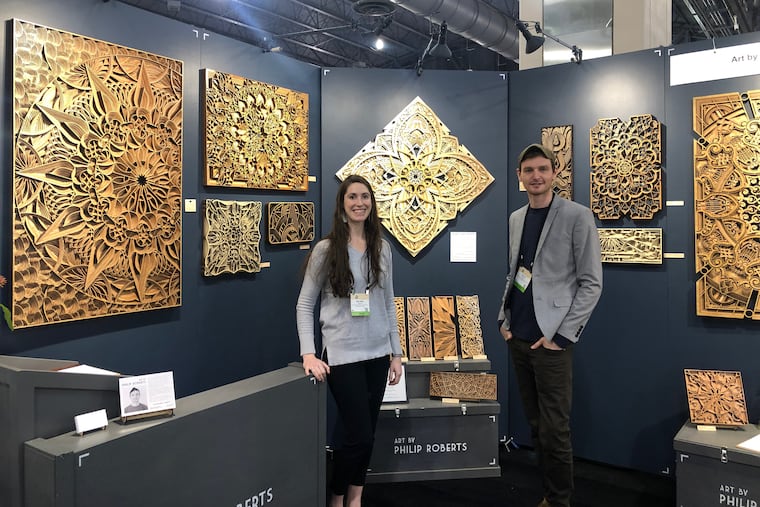For unique, American-made crafts, this Philly convention is the place to be
The annual American Handcrafted show in Philadelphia is the largest event of its kind according to the group’s website. It sells everything from hand-made ceramics, to crafted food and beverages, to jewelry made with recycled materials. Artists and buyers have been coming here for 30 years.

Standing in front of his intricate mandala-like wooden carvings at the annual American Handcrafted Philadelphia show, Phillip Roberts was attracting a consistent flow of customers from museum stores, galleries, and boutiques around North America.
His pieces have swirling rings of overlapping shapes and patterns, each with 12 layers of carved mahogany, white birch, and other woods that seem to be in motion. His most expensive wood carving, which is four feet wide, wholesales for $2,000 while the most popular one, at 32 by 24 inches, costs $1,000.
Roberts spends more than 100 hours designing each piece on a drawing tablet, cutting thin layers of wood separately and gluing them by hand. “Our generation loves tech and local handmade stuff," says Roberts, 31, of Southampton, Burlington County. "We are banking on it.”
Roberts is one of the 480 artists who had come from across the continent to sell unique, American-made crafts to more than 1,500 buyers, mostly museum stores, galleries, and boutiques. About 65 artists came from Philadelphia and New Jersey this year.
The annual American Handcrafted show, held at the Pennsylvania Convention Center, is the largest event of its kind according to the group’s website. It sells everything from handmade ceramics, to crafted food and beverages, to jewelry made with recycled materials. Artists and buyers have been coming here for over 30 years.
The event has lost two-thirds of its artists and clients in the last two decades due to such factors as the rise of internet shopping and the lingering effects of the 2008 recession. In the 1990s, there were more than 1,500 artists showing their crafts, longtime buyers said.
“They are much smaller now. It’s lucky to still have the show here in Philadelphia, but my fear is that this won’t continue if we don’t keep younger people interested,” said Tracy Tumolo, owner of Sweet Mabel, an American handcraft store in Narberth. Tumolo has been coming to the show to get clothes, home decor, jewelry, and accessories for 15 years.
“This is my go-to show because I know it’s all made here [in the U.S.]. When I go to other places, I have to ask if it was made here or were they made overseas. I want to support American artists.”
Allison Garafalo, show director of American Handcrafted, said a top priority is attracting young emerging artists. Garafalo is also the sales director at NY Now, a trade show company that took over the event three years ago. The company used to hold wholesale trade shows in Las Vegas and Orlando, but stopped last year to focus on the Philadelphia event. The company has been offering discount packages for young artists to take booths. And this measure has helped.
More than 1,000 of the 1,500 registered buyers made purchases in the first two days of the three-day show, which ended Monday, Garafalo said. Although her company feels the online competition from Amazon, artists, buyers, and consumers want face-to-face contact, and new exhibitors have joined in the last two years.
“I have seen a trend with the handmade products that younger generations want something unique and sustainable, and they want something that tells a story,” said Garafalo. “Owning something from a generic high-end brand like Louis Vuitton is not as popular anymore as saying, ‘Look at this designer I have found. She handcrafts everything in Portland, Oregon.’"
The company has worked to redefine luxury crafts as something non-generic that cannot be replaced and comes at a premium price. "No one is walking into the show expecting a cheap product. They know that a machine did not make this, that someone spent their days making this product, and it is going to sell [for] more,” Garafalo said.
Garafalo’s company holds seminars to educate buyers on the products they purchase to make sure they tell a good story to consumers. And the fact that the show has been standing firm in Philadelphia with enough demand means that young consumers are appreciating the work, says Garafalo.
Olivia Shih is a young emerging artist who flew from Oakland, Calif., to Philadelphia this year. She designs earrings and necklaces with 85 percent recycled gold and 100 percent recycled silver sourced from all over the US, including California and New Mexico.
“Buyers here appreciate craft and technical skills," said Shih, 30, who graduated from the California College of the Arts four years ago. Shih said this show gives her more orders than others.
“Young artists can graduate from art school and not have a clue about the market," said Fern Solomon, owner of Jacob’s Musical Chimes stores in Long Beach, Calif., and a show exhibitor since 1995. Solomon and her husband, Sam, held seminars with young artists and buyers last week to help them learn about the business. Solomon said coming to the Philadelphia show each year helped put her kids through college. “Without it, I would not have my stores.”
But her biggest satisfaction is seeing how the younger generation carries on their traditions despite changes in the industry. “We have had challenges from online [retail], but we are still here, and that makes me really happy.”